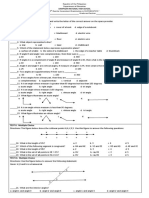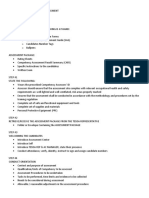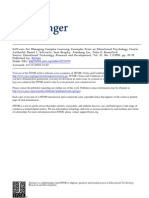0 ratings0% found this document useful (0 votes)
11 viewsMELINDA RIVAS-COC 1 AND COC 2 DEMO Guide
MELINDA RIVAS-COC 1 AND COC 2 DEMO Guide
Uploaded by
Melinda Beldad RivasThe document provides steps for demonstrating competency-based training (COC 1) and assessment (COC 2). For COC 1, the demonstration outlines preparing trainees, conducting pre-assessments, orientation, training activities like module delivery and skills validation, and post-training evaluation. For COC 2, the assessor prepares the work area and candidates, outlines the assessment purpose and process, gathers and evaluates evidence through skills observation and testing, provides feedback, and documents results. Both demonstrations aim to certify trainees' and candidates' competency through skills validation and evaluation.
Copyright:
© All Rights Reserved
Available Formats
Download as DOCX, PDF, TXT or read online from Scribd
MELINDA RIVAS-COC 1 AND COC 2 DEMO Guide
MELINDA RIVAS-COC 1 AND COC 2 DEMO Guide
Uploaded by
Melinda Beldad Rivas0 ratings0% found this document useful (0 votes)
11 views4 pagesThe document provides steps for demonstrating competency-based training (COC 1) and assessment (COC 2). For COC 1, the demonstration outlines preparing trainees, conducting pre-assessments, orientation, training activities like module delivery and skills validation, and post-training evaluation. For COC 2, the assessor prepares the work area and candidates, outlines the assessment purpose and process, gathers and evaluates evidence through skills observation and testing, provides feedback, and documents results. Both demonstrations aim to certify trainees' and candidates' competency through skills validation and evaluation.
Copyright
© © All Rights Reserved
Available Formats
DOCX, PDF, TXT or read online from Scribd
Share this document
Did you find this document useful?
Is this content inappropriate?
The document provides steps for demonstrating competency-based training (COC 1) and assessment (COC 2). For COC 1, the demonstration outlines preparing trainees, conducting pre-assessments, orientation, training activities like module delivery and skills validation, and post-training evaluation. For COC 2, the assessor prepares the work area and candidates, outlines the assessment purpose and process, gathers and evaluates evidence through skills observation and testing, provides feedback, and documents results. Both demonstrations aim to certify trainees' and candidates' competency through skills validation and evaluation.
Copyright:
© All Rights Reserved
Available Formats
Download as DOCX, PDF, TXT or read online from Scribd
Download as docx, pdf, or txt
0 ratings0% found this document useful (0 votes)
11 views4 pagesMELINDA RIVAS-COC 1 AND COC 2 DEMO Guide
MELINDA RIVAS-COC 1 AND COC 2 DEMO Guide
Uploaded by
Melinda Beldad RivasThe document provides steps for demonstrating competency-based training (COC 1) and assessment (COC 2). For COC 1, the demonstration outlines preparing trainees, conducting pre-assessments, orientation, training activities like module delivery and skills validation, and post-training evaluation. For COC 2, the assessor prepares the work area and candidates, outlines the assessment purpose and process, gathers and evaluates evidence through skills observation and testing, provides feedback, and documents results. Both demonstrations aim to certify trainees' and candidates' competency through skills validation and evaluation.
Copyright:
© All Rights Reserved
Available Formats
Download as DOCX, PDF, TXT or read online from Scribd
Download as docx, pdf, or txt
You are on page 1of 4
COC 1 AND COC 2 DEMO Guide
STEPS IN FACILITATING TRAINING ( COC 1 Demonstration)
( Prepare 2 trainees, must not be below 16 years of age)
1. Check and arrange resources for the Training
Post the 9 CBT areas
Post the progress chart and achievement chart
2. Introduction
Prayer
Introduce self as the Trainer
Ask for the admission slips
3. Check attendance
Thank the trainees for choosing your training center
Give a brief description of your training center
4. Administer the pre-assessment tools
Administer the learner’s profile – indicate the purpose
Administer the Self-assessment guide (SAG)- indicate the purpose
5. Validate the result of the SAG
6. Conduct general orientation- refer to your PowerPoint presentation
CBT
Principles of CBT – explain only 3 but read through the 10 principles
Discuss the roles of the Trainer
Discuss the roles of the Trainees
Discuss the course description of your qualification
Training Schedule, time and date
Discuss the house rules
7. Conduct pre-test – discuss the purpose
8. Conduct tour to the 9 CBT areas in your training center
9. Dismiss the class – remind the trainees who checked Yes in the
SAG to bring proof (certificates )
Second Day of the Demo
1. Prayer
2. Check attendance
3. Give a recap of the previous day
4. Post the training activity matrix – state the purpose
5. Validate prior learning
Get and validate the certificate (Trainee number 2)
6. Give CBLM to the trainee without prior knowledge ( Trainee
number 1)
7. Continue with the validation of prior learning
Conduct institutional assessment – WRITTEN TEST, DEMONSTRATION
AND ORAL INTERVIEW
Check the test paper, consolidate the results
Conduct feedbacking
Give the decision – COMPETENT
Give the certificate of achievement
Record in the progress chart and achievement chart
8. Give the next module (CBLM) for the next unit of competency to
the trainee with prior knowledge
9. Go to the trainee without prior knowledge Trainee number 1
Check on the progress
Check the results of the self check, task sheets, job sheet
Demonstrate to Trainee number 1 a procedure which you observed to
have not been performed correctly. Do the demonstration
Give Trainee number 1 time to practice
Ask if Trainee number 1 is ready for the Institutional assessment
Conduct institutional assessment - Written, demo and oral questioning
Consolidate the results
Do the feedbacking
Give the decision - COMPETENT
Award the certificate of achievement
Record in the progress chart and achievement chart
Give the CBLM for the next unit of competency
10. Back to Trainee number 2
Check performance
Ask if ready for the Institutional Assessment
Conduct Institutional Assessment- WRITTEN, DEMO, ORAL
QUESTIONING
Consolidate the result
Do the feedbacking
Give the decision – COMPETENT
Give the certificate of achievement
Record in the achievement chart and progress chart
Give the next module
11. REFER TO THE PROGRESS SHEET – Trainee number 2 is done
with all of the units of competency; while Trainee number 1 will continue
with the last unit of competency
- dismiss the class
12. Last day of the training
Prayer
Check attendance
Recap of the previous days
Conduct posttest to Trainee number 2- give the purpose of the post
test
Check the paper- COMPETENT
Give the feedback to Trainee number 2
Recommend to take the national assessment (NCII)
Give instructions what to prepare, how to apply for the national
assessment
Conduct training evaluation – give the purpose
For Trainee number 1, check the progress and give instructions for the
institutional assessment
END OF THE DEMONSTRATION
STEPS IN CONDUCTING COMPETENCY-BASED ASSESSMENT
(COC 2 DEMONSTRATION)
(Prepare 2 trainees, must not be below 16 years of age)
1. Checked and arranged resources required for the
assessment.
2. Prepare the candidate
Introduction of yourself as the Competency Assessor for the
qualification
Check attendance
Collect admission slip; check the signature the attendance sheet vs
Admission Slip and picture of the Candidate
Acknowledge the TESDA representative and the AC manager and their
roles in the assessment
3. Establish the purpose of the assessment; the competence
standards (core competencies) to be assessed and the context of the
assessment (how the assessment is administered).
State the purpose of the assessment (to be a certified (qualification)
holder.
State the qualification title, units of competency and the number of
clusters of the competency (is clustered)
State the assessment procedures/methods (written test, demo and
oral questioning), tasks to be performed, role of the assessor, time
allotted
Explain reasonable adjustment, legal and ethical responsibilities;
explain confidentiality of the assessment process
Remind candidates for safety precautions/ contingency actions
4. Gather evidences
Give specific instructions on what to do
Collect evidences based on the methodologies in the Evidence Plan
Ask the candidates to perform; observe and take down notes as the
candidate perform. Note unusual conditions in the rating sheet.
5. Evaluate evidences
Evaluate evidences (check finish products)
6. Provide feedback
Discuss the assessment process
Give first the constructive and positive feedback; identify the tasks
performed well and then the areas to be improved and how to
overcome the gaps.
Give feedback using the answer sheet, rating sheet and the list of
questions as reference. (Written, demo and oral questioning)
For the not yet competent candidate- encourage to practice more, that
he/she was not able to perform based on the required standards;
encouraged to take another national assessment.
Let the candidates sign the rating sheet to confirm the decision of the
assessor.
7. Recording and reporting of the results of the assessment
Record all the results in the rating sheet
Assessor will sign the Rating Sheet and the CARS (Competency assessment
result summary)
Detach the claim slip in the CARS and give to the candidate (to be used in
claiming the certificate)
Instruct candidate to claim his national certificate from the TESDA Provincial
Office, 5 working days from the date of assessment; bring 50 pesos for the
certificate and 1 pc passport size ID picture ( for the competent candidates)
Advice the NYC ( Not yet competent) candidate what to prepare and submit
for re-assessment; encourage him to do better in the next assessment.
Submit the Attendance Sheet, Rating Sheet, CARS and RWAC
( Registry of Workers Assessed and Certified) to the TESDA representative.
( Note: The Processing Officer prepares the RWAC)
You might also like
- CPCCPD3025 Assessment 1Document17 pagesCPCCPD3025 Assessment 1tannu263No ratings yet
- 3rd Quarter Exam in Math 7Document3 pages3rd Quarter Exam in Math 7Marivic Labuac95% (37)
- ICTSAS527 AssessmentsDocument75 pagesICTSAS527 AssessmentsAmrit SapkotaNo ratings yet
- SP 3 - Summative Assessment MemorandaDocument134 pagesSP 3 - Summative Assessment Memorandakgosipeter79No ratings yet
- +CPCCWHS2001 Assessment - Practical AMBDocument67 pages+CPCCWHS2001 Assessment - Practical AMBaishaNo ratings yet
- Guidelines For TM 1 National AssessmentDocument7 pagesGuidelines For TM 1 National AssessmentIvy Rosell Buayaban100% (6)
- Provide Feedback To CandidatesDocument11 pagesProvide Feedback To Candidatesjonellambayan92% (12)
- Pmi-Acp Exam Prep Study Guide: Extra Preparation for Pmi-Acp Certification ExaminationFrom EverandPmi-Acp Exam Prep Study Guide: Extra Preparation for Pmi-Acp Certification ExaminationNo ratings yet
- CPCCOM3006 Assessment THEORYDocument46 pagesCPCCOM3006 Assessment THEORYPriyanka Devi100% (1)
- Cca PackageDocument8 pagesCca Packagealyazeed Ladjamatli100% (2)
- Meeting the Assessment Requirements of the Award in Education and TrainingFrom EverandMeeting the Assessment Requirements of the Award in Education and TrainingNo ratings yet
- FTS-CCA Review1Document10 pagesFTS-CCA Review1Armando Delos SantosNo ratings yet
- Conduct Competency Assessment - Docx Script BayDocument3 pagesConduct Competency Assessment - Docx Script BayYousuf Yang73% (11)
- Trainer'S Methodology Assessment: Coc 1 Coc 2Document14 pagesTrainer'S Methodology Assessment: Coc 1 Coc 2G75% (4)
- Competency Assessment-STEPSDocument7 pagesCompetency Assessment-STEPSjonsautiNo ratings yet
- Institutional-Assessment-Tool For Traners MethodologyDocument5 pagesInstitutional-Assessment-Tool For Traners MethodologyBrad PhettNo ratings yet
- CPCCWF3007 Student Pack V10.0Document99 pagesCPCCWF3007 Student Pack V10.0chepkoechronnice13No ratings yet
- LarareportsDocument79 pagesLarareportsPot-Pot LoboNo ratings yet
- Coc 2Document2 pagesCoc 2Daniel Reyes100% (1)
- Course Overview, CBA, OBADocument64 pagesCourse Overview, CBA, OBAJade TijamNo ratings yet
- Student and Trainer DetailsDocument102 pagesStudent and Trainer DetailsAmandeep KarwalNo ratings yet
- CPCCCM2006 Assessment THEORYDocument32 pagesCPCCCM2006 Assessment THEORYPriyanka DeviNo ratings yet
- Student Assessment - SITHCCC027 Prepare Dishes Using Basic MethodDocument51 pagesStudent Assessment - SITHCCC027 Prepare Dishes Using Basic Methodkomalattwal886No ratings yet
- Role of The Assessor, Candidate, ModeratorDocument5 pagesRole of The Assessor, Candidate, ModeratorWalter Evans Lasula0% (1)
- Steps in Conducting Competency AssessmentDocument8 pagesSteps in Conducting Competency Assessment라영민67% (3)
- +CPCCWHS2001 Assessment - Theory AMBDocument22 pages+CPCCWHS2001 Assessment - Theory AMBH .SNo ratings yet
- +CPCCWHS2001 Assessment - Practical AMB (1) (1) (1)-1Document52 pages+CPCCWHS2001 Assessment - Practical AMB (1) (1) (1)-1hammadbhatti0111No ratings yet
- SITHCCC006 Student Assessment PackDocument81 pagesSITHCCC006 Student Assessment Packshreyansh jainNo ratings yet
- SAQA - 8420 - Summative AssessmentDocument23 pagesSAQA - 8420 - Summative AssessmenthamidyalcouyeNo ratings yet
- CPCCOM3006 Assessment THEORYDocument29 pagesCPCCOM3006 Assessment THEORYali03446254No ratings yet
- Guide For FT S and CCADocument2 pagesGuide For FT S and CCAJohn Rhino SantosNo ratings yet
- SAQA - 14909 - Summative MemorandumDocument22 pagesSAQA - 14909 - Summative MemorandumkabeloNo ratings yet
- Conducting Pre-Assessment: Lesson 5Document20 pagesConducting Pre-Assessment: Lesson 5Jentry RondanNo ratings yet
- OBSERVATION CHECKLIST - COC 2 Assessor's Methodology: Document NeededDocument2 pagesOBSERVATION CHECKLIST - COC 2 Assessor's Methodology: Document NeededNorway Alinea MedinaNo ratings yet
- Conduct Competency AssessmentDocument12 pagesConduct Competency AssessmentCrash ZerocoolNo ratings yet
- PeppaDocument2 pagesPeppaRosemarie GranadosNo ratings yet
- SAQA 8964 - Summative AssessmentsDocument23 pagesSAQA 8964 - Summative AssessmentsNomsa ZunguNo ratings yet
- Written Report GuideDocument4 pagesWritten Report GuideCindyNo ratings yet
- SAQA 8964 - Summative AssessmentsDocument24 pagesSAQA 8964 - Summative AssessmentsTapiwa Glen Dube MdangweNo ratings yet
- Conduct Competency Asessment1Document34 pagesConduct Competency Asessment1Nette de Guzman100% (1)
- Information Sheet 1.1-6 Trainees' Current Competencies: Learning ObjectivesDocument19 pagesInformation Sheet 1.1-6 Trainees' Current Competencies: Learning Objectivesmaemae100% (1)
- Student and Trainer Details: Jasbir Singh 0431554710 Mr. Harish RawalDocument45 pagesStudent and Trainer Details: Jasbir Singh 0431554710 Mr. Harish RawalJaydeep KushwahaNo ratings yet
- SAQA - 14909 - Summative AssessmentDocument21 pagesSAQA - 14909 - Summative AssessmentkabeloNo ratings yet
- EAW5 Interview Preparation - WLI Student Assessment Pack TemplateDocument9 pagesEAW5 Interview Preparation - WLI Student Assessment Pack TemplateLinh Đan TrầnNo ratings yet
- Institutional Assessment Tool TmiDocument10 pagesInstitutional Assessment Tool TmiMyka Mae Edep LasernaNo ratings yet
- General Instructions For The Competency AssessorDocument18 pagesGeneral Instructions For The Competency AssessorKathrine AngelesNo ratings yet
- Trainees Training Requirements PDFDocument29 pagesTrainees Training Requirements PDFMeriella Dane SabilonaNo ratings yet
- SAQA - 261666 - Summative AssessmentsDocument17 pagesSAQA - 261666 - Summative AssessmentsramukhubacafeNo ratings yet
- SITXWHS005 Student PackDocument61 pagesSITXWHS005 Student Packftraya2000No ratings yet
- Job Sheet 2.4 - 1Document2 pagesJob Sheet 2.4 - 1Bernard HernandezNo ratings yet
- SAQA 119176 Summative AssessmentsDocument23 pagesSAQA 119176 Summative Assessmentsmotloungtshidiso527No ratings yet
- Sitxwhs003 Student Pack v1.0Document74 pagesSitxwhs003 Student Pack v1.0adnan malikNo ratings yet
- Summative AssessmentDocument20 pagesSummative AssessmentPhindile NokwandaNo ratings yet
- FLS Rating SheetDocument3 pagesFLS Rating SheetMARIA VICTORIA CENTINANo ratings yet
- Summative Assessment MemorandumDocument25 pagesSummative Assessment MemorandumForbetNo ratings yet
- Student and Trainer Details: Jasbir Singh 0431554710 Mr. Harish RawalDocument39 pagesStudent and Trainer Details: Jasbir Singh 0431554710 Mr. Harish RawalJaydeep KushwahaNo ratings yet
- CCA ChecklilstsDocument2 pagesCCA ChecklilstsMarveen TingkahanNo ratings yet
- Coc2 Sequence - Conduct Competency AssessmentDocument4 pagesCoc2 Sequence - Conduct Competency AssessmentFitzgerald PachecoNo ratings yet
- Beyond the Bubble Test: How Performance Assessments Support 21st Century LearningFrom EverandBeyond the Bubble Test: How Performance Assessments Support 21st Century LearningNo ratings yet
- How To Pass The CPA Exam: The IPassTheCPAExam.com Guide for International CandidatesFrom EverandHow To Pass The CPA Exam: The IPassTheCPAExam.com Guide for International CandidatesRating: 5 out of 5 stars5/5 (1)
- How to Practice Before Exams: A Comprehensive Guide to Mastering Study Techniques, Time Management, and Stress Relief for Exam SuccessFrom EverandHow to Practice Before Exams: A Comprehensive Guide to Mastering Study Techniques, Time Management, and Stress Relief for Exam SuccessNo ratings yet
- Creativenonfictionweek 2 Quiz 2 Oct 2125Document1 pageCreativenonfictionweek 2 Quiz 2 Oct 2125Melinda Beldad RivasNo ratings yet
- Script COC 1Document10 pagesScript COC 1Melinda Beldad RivasNo ratings yet
- Statement of PurposeDocument3 pagesStatement of PurposeMelinda Beldad Rivas100% (1)
- MELINDA RIVAS - RESUME For BPODocument2 pagesMELINDA RIVAS - RESUME For BPOMelinda Beldad RivasNo ratings yet
- Unitplan Tle10 Q3Document6 pagesUnitplan Tle10 Q3Melinda Beldad RivasNo ratings yet
- Mammography CMEDocument1 pageMammography CMEKirstie Marie SaldoNo ratings yet
- Circular 1807Document31 pagesCircular 1807NikunjNo ratings yet
- Ep 3Document9 pagesEp 3Dodong RiderNo ratings yet
- SUMMARY OF REPORT - Life and Works of RizalDocument4 pagesSUMMARY OF REPORT - Life and Works of RizalJoshua Lander Soquita CadayonaNo ratings yet
- Udl Lesson Plan Form Butterfly 1Document4 pagesUdl Lesson Plan Form Butterfly 1api-239447816No ratings yet
- SCCG3123 Ia1 238529Document5 pagesSCCG3123 Ia1 238529نور شهبره فانوتNo ratings yet
- Transcript SandyDocument4 pagesTranscript Sandy7qv49rn925No ratings yet
- Seminar For Success (Sos) Syllabus: Course DescriptionDocument3 pagesSeminar For Success (Sos) Syllabus: Course DescriptionRicardo RamosNo ratings yet
- Week 2 Reading and Writing Edited (April)Document5 pagesWeek 2 Reading and Writing Edited (April)Vanessa VayeNo ratings yet
- L21-Progress Test 2 - ANSWER KEY - FOR TEACHERDocument2 pagesL21-Progress Test 2 - ANSWER KEY - FOR TEACHERPhạm Khắc TrungNo ratings yet
- Performance Assessment Matrix VISION BOARDDocument4 pagesPerformance Assessment Matrix VISION BOARDJobert BonielNo ratings yet
- AGU International Students AppliDocument7 pagesAGU International Students AppliDaffa DienataNo ratings yet
- Programm Guide BSW English PDFDocument71 pagesProgramm Guide BSW English PDFAkash MalviyaNo ratings yet
- Authentic AssessmentDocument11 pagesAuthentic AssessmentEriel Rose Magno RedublaNo ratings yet
- 01 English For Libya Teacher BookDocument15 pages01 English For Libya Teacher Bookpjlewis2024No ratings yet
- Wide Open: Wallet Half ShutDocument47 pagesWide Open: Wallet Half Shutapi-264674410% (1)
- Unit 8 CitiesDocument4 pagesUnit 8 CitiesJorn TravoltaNo ratings yet
- Current ResumeDocument3 pagesCurrent Resumeapi-582489562No ratings yet
- TAO Journal ReportDocument29 pagesTAO Journal ReportLevindo Pereira100% (1)
- Republic Colleges of Guinobatan IncDocument4 pagesRepublic Colleges of Guinobatan IncMaricson Bas100% (1)
- No Phone or Address ResumeDocument3 pagesNo Phone or Address Resumeapi-500305326No ratings yet
- Minutes of MeetingDocument4 pagesMinutes of MeetingEric DumlaoNo ratings yet
- Kinder DLLDocument8 pagesKinder DLLMylene TabiosNo ratings yet
- Schwartz Et AlDocument22 pagesSchwartz Et AlAnthony PetrosinoNo ratings yet
- THESIS-final-JAI-JEN 2Document25 pagesTHESIS-final-JAI-JEN 2Krizna Dingding DotillosNo ratings yet
- Lesson 2: The Code of Ethics For Professional Teachers: Relationship With The Secondary and Tertiary StakeholdersDocument48 pagesLesson 2: The Code of Ethics For Professional Teachers: Relationship With The Secondary and Tertiary StakeholdersJohn Frits Gerard MombayNo ratings yet
- Successful Homework ClubsDocument5 pagesSuccessful Homework Clubsh45nhdnd100% (1)
- Code of Professional ResponsibilityDocument6 pagesCode of Professional ResponsibilityKrisven Mae R. ObedoNo ratings yet
- Pta Meeting 2024Document5 pagesPta Meeting 2024aprilyn.fabianNo ratings yet






























































































